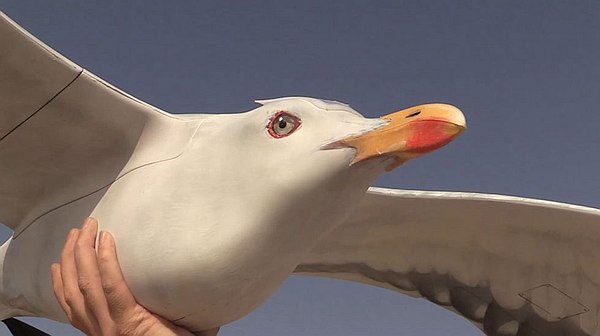Podcast: Play in new window | Download (Duration: 33:47 — 23.3MB)
Avian biomimicry, stadium sanitizing with a drone, a Galileo competition, a new HALE flies, drones and electromagnetic pulses, wildfire data from drones, new standards from EASA, an F-15 with a loyal wingman under its wing.
UAV News

A Bird James Bond Might Love
Netherlands-based The Drone Bird Co. knows something about biomimicry. The company has used flapping drones masquerading peregrine falcons to disburse populations of pest birds. Now the company has a non-flapping series called Aves (“aves” being Latin for “birds.”) CEO Jan-Willem van den Eijkel: “The AVES series is basically a very big fixed-wing bird whether it’s a gull, a hawk or an eagle. You can make any shape, but the gull was the most ambitious because of the wing shape. If you look at the gull, you’ll see there is no tail or stabilizer, so to make it look like the gull and fly stably, we had to test and develop a lot.”
Pennsylvania company using disinfecting drones to help fans return to stadiums in fall
Aeras Fog Company says their drone can sanitize an entire stadium in three hours. The 50-pound MG1S drone can spray disinfectant up to 20 acres-an-hour. People can occupy the sanitized space within three minutes. The drone is similar to those used for fertilizing crop fields.
MyGalileoDrone competition seeks UAV innovations
The European GNSS Agency (GSA) has launched the MyGalileoDrone competition. “The aim of the contest is to design, develop, test, and prepare for commercial launch a drone-based application and/or service able to provide a position and/or time fix by using a Galileo-enabled receiver.” Galileo can be used on the drone, smartphone app, payload, or in any other device supporting the Galileo drone application. Initial ideas should be submitted by Aug. 31, 2020.
American Made Swift High-Altitude-Long-Endurance UAS Completes Landmark First Flight
Swift Engineering‘s high altitude long endurance (HALE) UAS completed its maiden flight at New Mexico’s Spaceport America. The Swift HALE UAS is designed to operate unmanned at 70,000 feet and offers 24-hour persistent and stable upper atmosphere operations for commercial and military surveillance, monitoring, communications, and security applications. The 72-foot solar-powered air vehicle weighs less than 180 pounds and can safely carry up to 15-pound payloads for missions.
Northrop Grumman to use Epirus’ C-UAS EMP weapon system
Northrop Grumman will use the Leonidas electromagnetic pulse (EMP) weapon system from Epirus. Leonidas uses solid-state commercial semiconductor technology for C-UAS defense and when fired, it creates an EMP that can be directed for precision targeting. It can “sanitise a volume of terrain or sky, creating a force field effect.” This will become part of the Northrop Grumman Counter-Unmanned Aerial System (C-UAS) systems-of-systems solution offering.
Plymouth Rock Technologies Forms Strategic Alliance With Hummingbird Drones to Fight Wildfire Threats
Plymouth Rock Technologies Inc. (PRT) develops threat detection technologies while Hummingbird Drones deals with wildfire analysis from drones. The companies are working together to mount sensors on drones and provide software that allows live actionable data for wildfire analysis.
EASA publishes proposed standards for certification of light drones
The European Union Aviation Safety Agency (EASA) has proposed Special Condition Light UAS standards in a 31-page draft document. The standards are applicable to unmanned aircraft under 600 Kg with no occupants. EASA is defining risk-based certification requirements. The proposal is open for public comments until September 30, 2020.
F-15 Eagle Seen Loaded With Loyal Wingman Drone For Previously Unknown Tests
An F-15C was photographed in a hangar with a loyal wingman drone attached to its left underwing pylon. The modified UTAP-22 Mako is from Kratos Defense and Security Solutions. The UTAP-22 reportedly has a price of between $2 and $3 million, can carry up 350 pounds of stores or other payloads, plus an additional 500 pounds of stores externally on underwing pylons and wingtip pods.
Video of the Week
360° video – The NRC’s Aerial Robotics Laboratory
The National Research Council of Canada’s Aerial Robotics Laboratory is an indoor drone testing environment designed for the development of contact-based drone applications on elevated structures.
